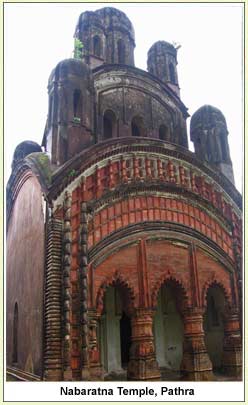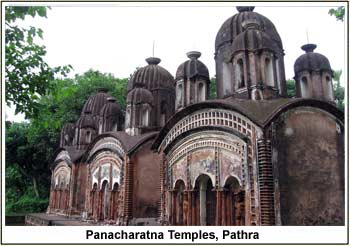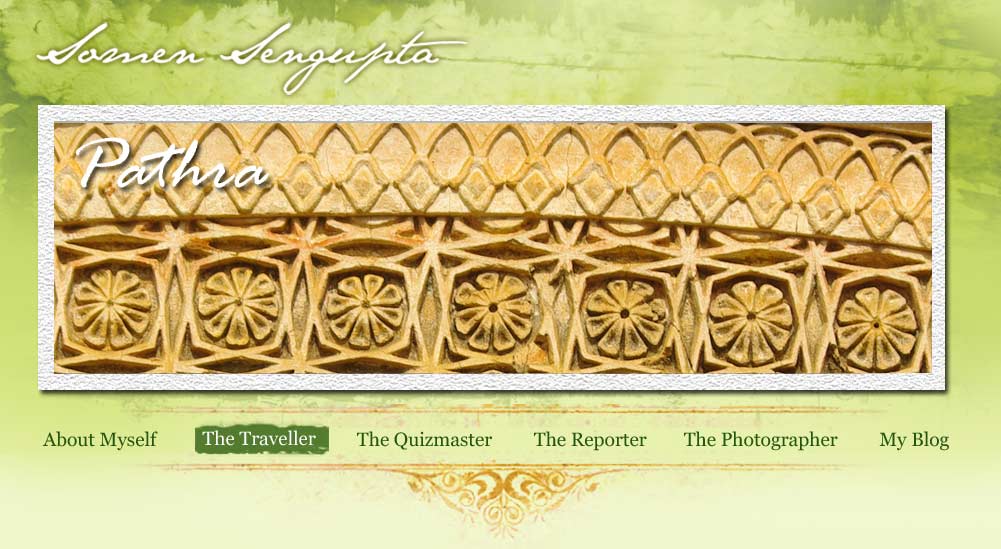| Pathra, on the bank of the river Kangsabati, is a village of temples. There are 34 temples in the village, all over 200 years old. Barely 10 km from Midnapore town, this nondescript hamlet is a treasure trove for those who like to travel back in time.The history of Pathra goes back to the Gupta age, when the place was the hinterland of Tamralipta port, a gateway to southeast Asia. From 8th Century to 12th Century, it was an important hub for Hindus, Jains and Buddhists. A majestic Vishnu Lokeshwar statue dug out in the village in October 1961 revealed both Hindu and Buddhist influences, indicating that practitioners of both religions frequented Pathra.
The turning point in the history of the village came in 1732, when Nawab Alivardi Khan appointed Bidyananda Ghoshal as the revenue collector of Ratnachawk pargana. Bidyananda established temple after temple in the village, making it a major draw for Hindu pilgrims. The nawab, however, was not too pleased with Bidyananda’s work. He was thrown into prison and then sentenced to death. Legend has it that the elephant that was to crush Bidyananda’s head refused to do so. The village reportedly gets its name from the incident.
The Ghoshal family changed its surname to Majumdar and continued building temples till the end of the 18th Century. Another branch of the family, with surname Bandopadhyay, also started constructing temples. With indigo cultivation and silk trade boosting the family’s fortunes, funds were not difficult to come by.
The decline started as the rich families shifted base from the village and ignorant local residents started vandalising the temples. Many of the structures were reduced to rubble. There was neither any initiative from the government nor from the academic circle to preserve the structures.
The efforts of a local resident named Yeasin Pathan and a handful of scholars from the mid-1960s finally bore fruit in the form of government grant and technical assistance from IIT Kharagpur in saving the temples. A slice of Bengal’s glorious past was salvaged in the nick of time. Today, 28 out of 34 temples in Pathra are under the supervision of the Archaeological Survey of India. It has repaired 18 temples. A non-government organisation named Pathra Archaeological Preservation Committee also looks after the structures.
The navaratna temple on the western bank of the river is the grandest. The 250-year-old, 40-ft high structure has nine towers and many terracotta panels on its walls. A small aatchala temple established in 1816 stands in the same compound.
Just opposite to it is a cluster of three aatchala temples and a small navaratna temple called Shivalaya. Terracotta artworks adorn these temples, too. Behind them is a Durga dalan, a temple-like structure made of stone.
 Some distance away is another group of pancharatna temples, built in the typical Bengal style and enriched with terracotta sculptures. Most of the temples offer glimpses of Islamic architectural styles. Stucco lime and seashell are the main materials used. The terracotta panels that still exist bear images of Ram, Balaram, Radha and Krishna, Dashavatar, Hanuman, Durga and hunting. The majority of the temples are dedicated to Krishna, Vishnu and Shiva. The second biggest temple of Pathra is a Sitala temple popularly known as Burimar than. It, too, is 40 ft high. The other important temples are Sarba Mangal, Kalachand, Das Mahavidya and Hansa. There’s also a simple yet attractive rasmancha, built in 1832. It has nine small towers. Some distance away is another group of pancharatna temples, built in the typical Bengal style and enriched with terracotta sculptures. Most of the temples offer glimpses of Islamic architectural styles. Stucco lime and seashell are the main materials used. The terracotta panels that still exist bear images of Ram, Balaram, Radha and Krishna, Dashavatar, Hanuman, Durga and hunting. The majority of the temples are dedicated to Krishna, Vishnu and Shiva. The second biggest temple of Pathra is a Sitala temple popularly known as Burimar than. It, too, is 40 ft high. The other important temples are Sarba Mangal, Kalachand, Das Mahavidya and Hansa. There’s also a simple yet attractive rasmancha, built in 1832. It has nine small towers.
City planning students at IIT Kharagpur have done extensive research on Pathra. They have proposed to develop the village as a heritage tourism destination.
Trip tips
Pathra is a two-hour drive from the city. The road inside the village can be difficult to navigate after a spell of rain. Pathra can be reached through Kharagpur as well. Contact Pathra Archaeological Preservation Committee (Phone: 9932785126) for additional information. Pack food and water..
|



